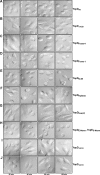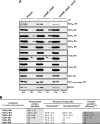Impact of the N-terminal secretor domain on YopD translocator function in Yersinia pseudotuberculosis type III secretion
- PMID: 21965570
- PMCID: PMC3232875
- DOI: 10.1128/JB.00210-11
Impact of the N-terminal secretor domain on YopD translocator function in Yersinia pseudotuberculosis type III secretion
Abstract
Type III secretion systems (T3SSs) secrete needle components, pore-forming translocators, and the translocated effectors. In part, effector recognition by a T3SS involves their N-terminal amino acids and their 5' mRNA. To investigate whether similar molecular constraints influence translocator secretion, we scrutinized this region within YopD from Yersinia pseudotuberculosis. Mutations in the 5' end of yopD that resulted in specific disruption of the mRNA sequence did not affect YopD secretion. On the other hand, a few mutations affecting the protein sequence reduced secretion. Translational reporter fusions identified the first five codons as a minimal N-terminal secretion signal and also indicated that the YopD N terminus might be important for yopD translation control. Hybrid proteins in which the N terminus of YopD was exchanged with the equivalent region of the YopE effector or the YopB translocator were also constructed. While the in vitro secretion profile was unaltered, these modified bacteria were all compromised with respect to T3SS activity in the presence of immune cells. Thus, the YopD N terminus does harbor a secretion signal that may also incorporate mechanisms of yopD translation control. This signal tolerates a high degree of variation while still maintaining secretion competence suggestive of inherent structural peculiarities that make it distinct from secretion signals of other T3SS substrates.
Figures











Similar articles
-
Coiled-coils in the YopD translocator family: a predicted structure unique to the YopD N-terminus contributes to full virulence of Yersinia pseudotuberculosis.Infect Genet Evol. 2012 Dec;12(8):1729-42. doi: 10.1016/j.meegid.2012.07.016. Epub 2012 Aug 11. Infect Genet Evol. 2012. PMID: 22910185
-
Yersinia pseudotuberculosis YopD mutants that genetically separate effector protein translocation from host membrane disruption.Mol Microbiol. 2015 May;96(4):764-78. doi: 10.1111/mmi.12970. Epub 2015 Mar 16. Mol Microbiol. 2015. PMID: 25684661
-
YopD self-assembly and binding to LcrV facilitate type III secretion activity by Yersinia pseudotuberculosis.J Biol Chem. 2010 Aug 13;285(33):25269-84. doi: 10.1074/jbc.M110.144311. Epub 2010 Jun 4. J Biol Chem. 2010. PMID: 20525687 Free PMC article.
-
Regulation of the Yersinia type III secretion system: traffic control.Front Cell Infect Microbiol. 2013 Feb 6;3:4. doi: 10.3389/fcimb.2013.00004. eCollection 2013. Front Cell Infect Microbiol. 2013. PMID: 23390616 Free PMC article. Review.
-
Links between type III secretion and extracytoplasmic stress responses in Yersinia.Front Cell Infect Microbiol. 2012 Oct 10;2:125. doi: 10.3389/fcimb.2012.00125. eCollection 2012. Front Cell Infect Microbiol. 2012. PMID: 23087910 Free PMC article. Review.
Cited by
-
Type III secretion by Yersinia pseudotuberculosis is reliant upon an authentic N-terminal YscX secretor domain.Mol Microbiol. 2022 Apr;117(4):886-906. doi: 10.1111/mmi.14880. Epub 2022 Feb 8. Mol Microbiol. 2022. PMID: 35043994 Free PMC article.
-
Genetically engineered frameshifted YopN-TyeA chimeras influence type III secretion system function in Yersinia pseudotuberculosis.PLoS One. 2013 Oct 3;8(10):e77767. doi: 10.1371/journal.pone.0077767. eCollection 2013. PLoS One. 2013. PMID: 24098594 Free PMC article.
-
Functional and computational analysis of amino acid patterns predictive of type III secretion system substrates in Pseudomonas syringae.PLoS One. 2012;7(4):e36038. doi: 10.1371/journal.pone.0036038. Epub 2012 Apr 27. PLoS One. 2012. PMID: 22558318 Free PMC article.
-
LcrQ Coordinates with the YopD-LcrH Complex To Repress lcrF Expression and Control Type III Secretion by Yersinia pseudotuberculosis.mBio. 2021 Jun 29;12(3):e0145721. doi: 10.1128/mBio.01457-21. Epub 2021 Jun 22. mBio. 2021. PMID: 34154409 Free PMC article.
-
Macrophage innate immune responses delineate between defective translocon assemblies produced by Yersinia pseudotuberculosis YopD mutants.Virulence. 2023 Dec;14(1):2249790. doi: 10.1080/21505594.2023.2249790. Virulence. 2023. PMID: 37621095 Free PMC article.
References
-
- Aili M., Isaksson E. L., Hallberg B., Wolf-Watz H., Rosqvist R. 2006. Functional analysis of the YopE GTPase-activating protein (GAP) activity of Yersinia pseudotuberculosis. Cell Microbiol. 8:1020–1033 - PubMed
-
- Akeda Y., Galan J. E. 2005. Chaperone release and unfolding of substrates in type III secretion. Nature 437:911–915 - PubMed
Publication types
MeSH terms
Substances
LinkOut - more resources
Full Text Sources

